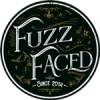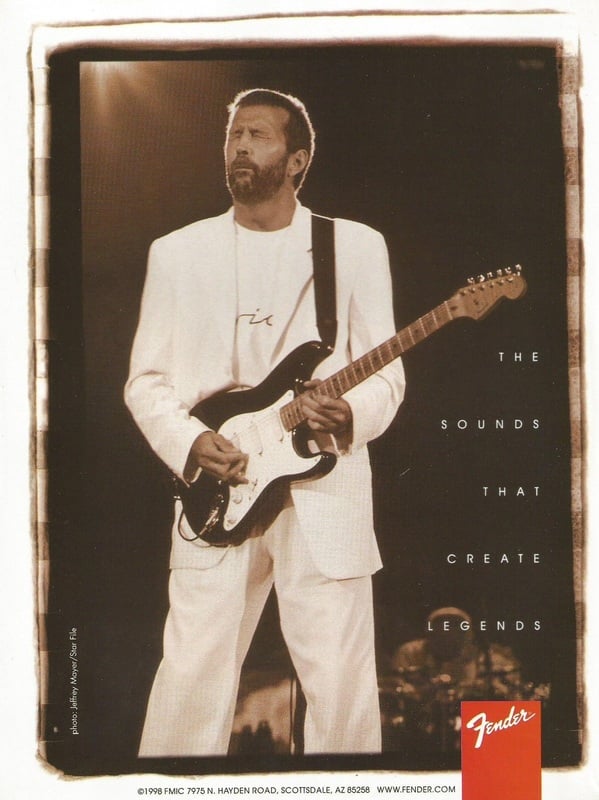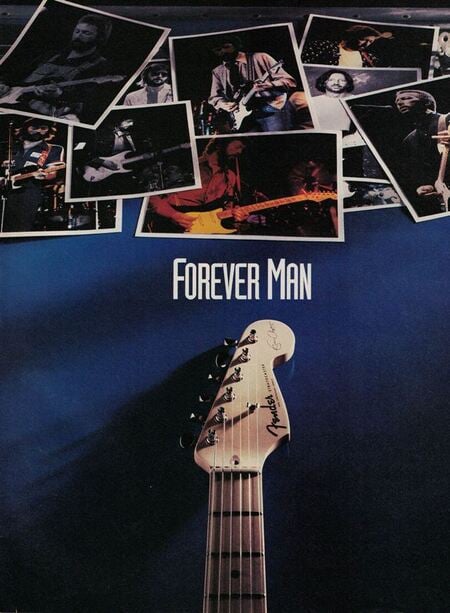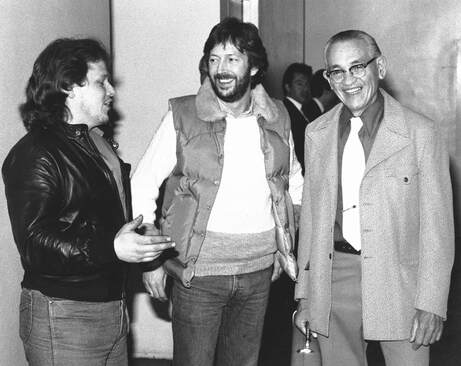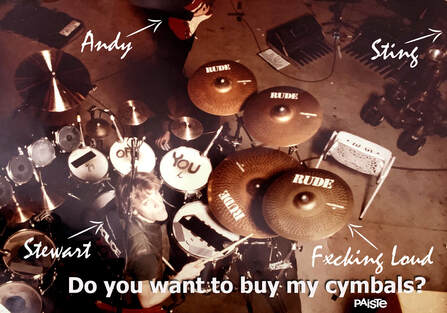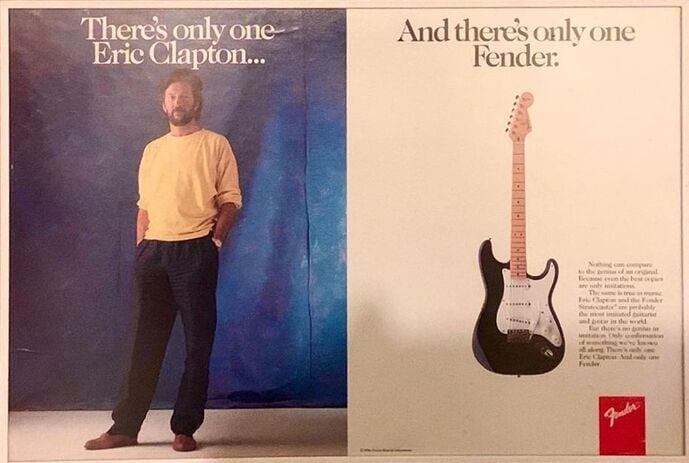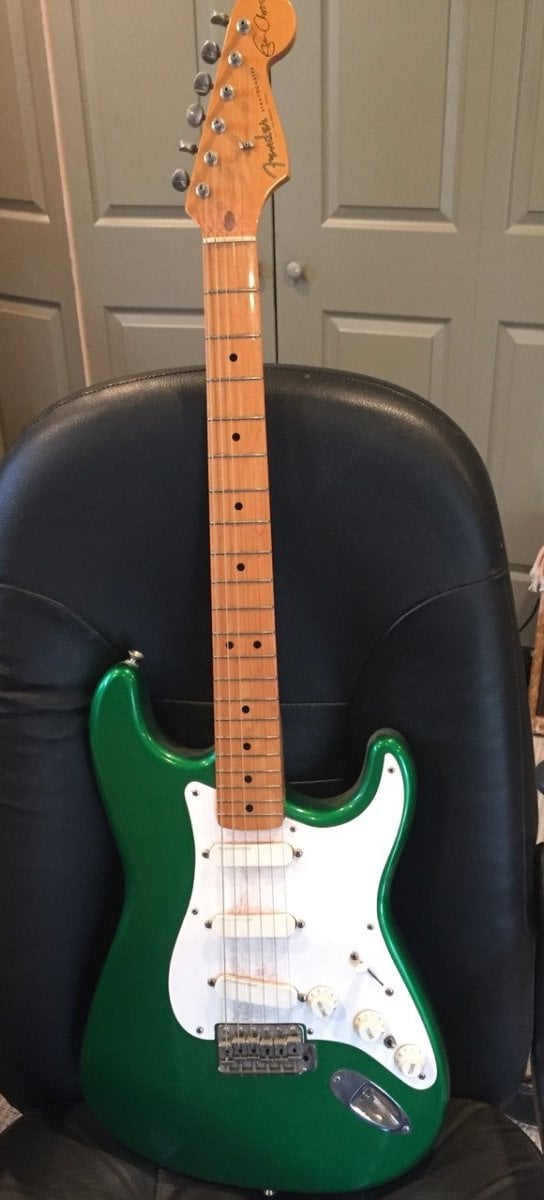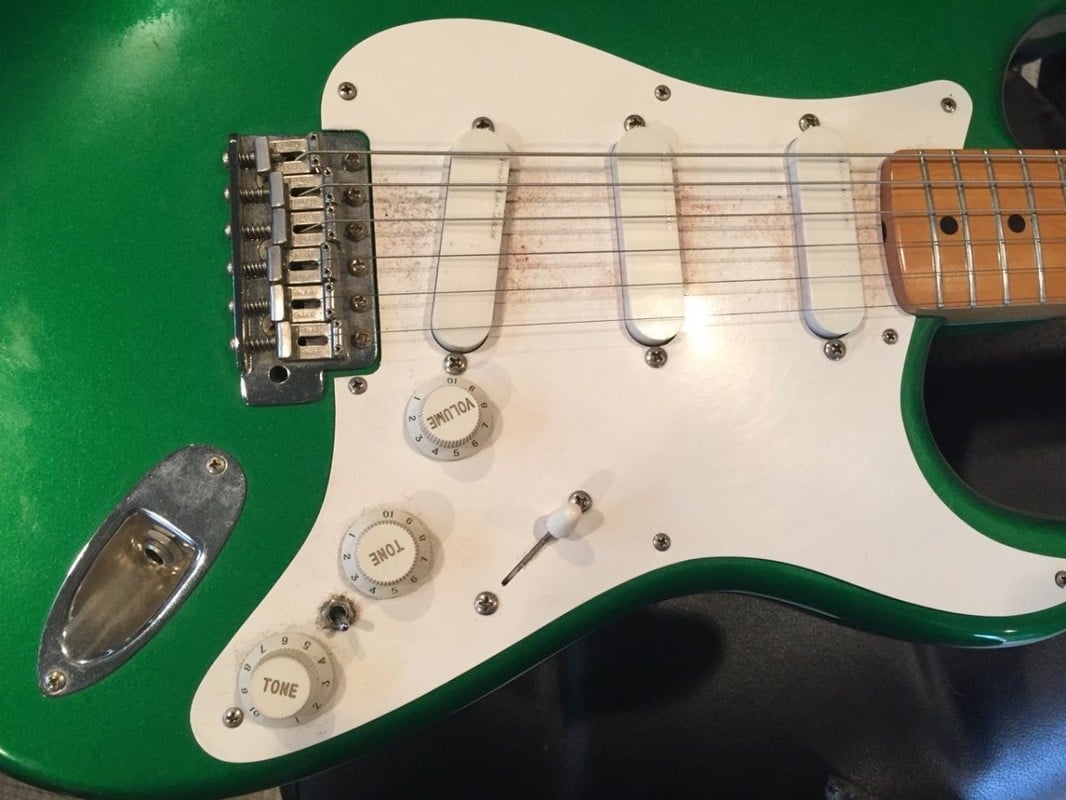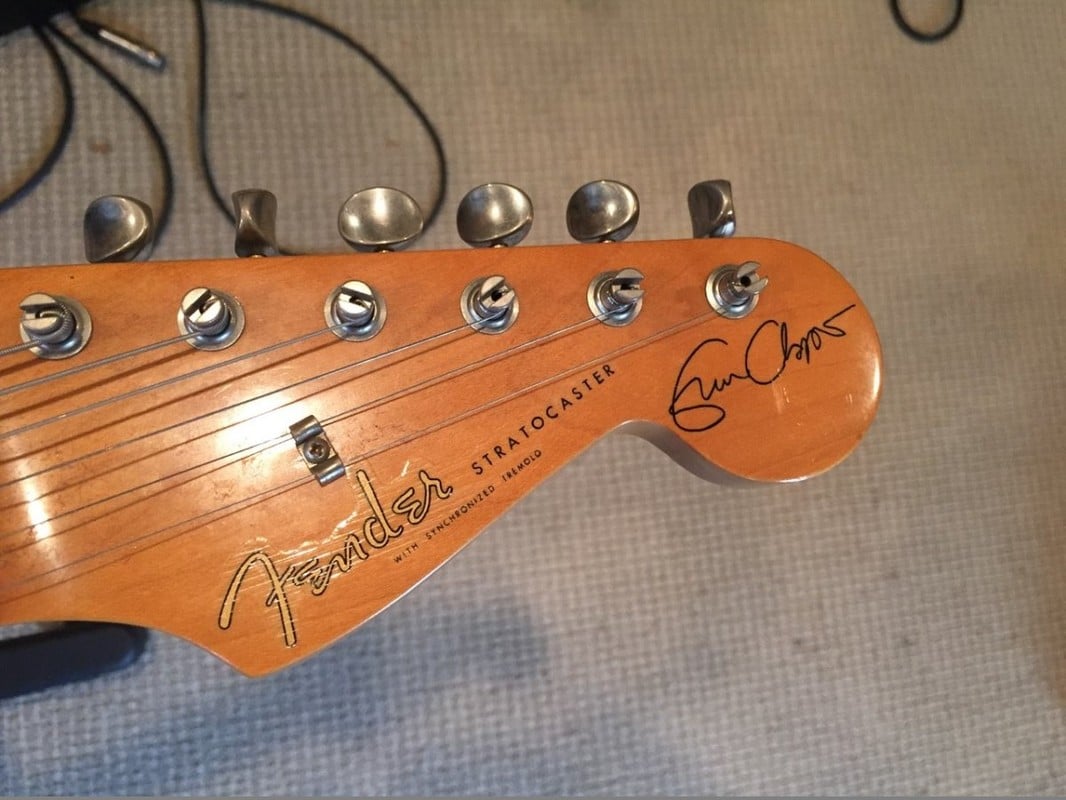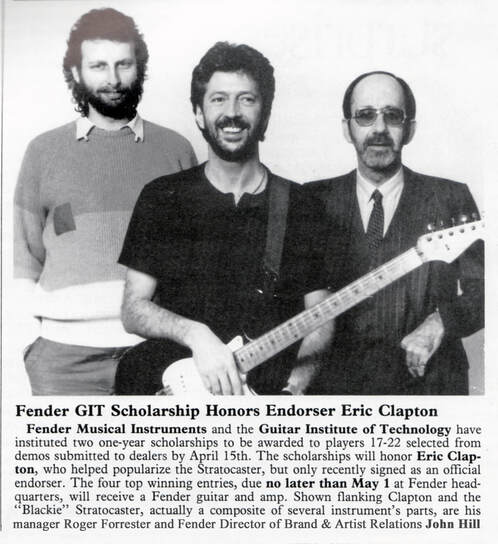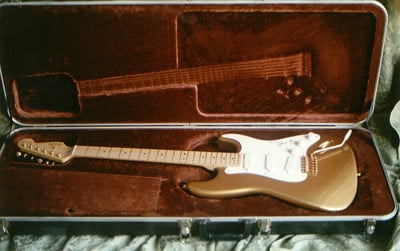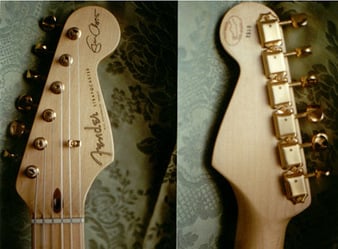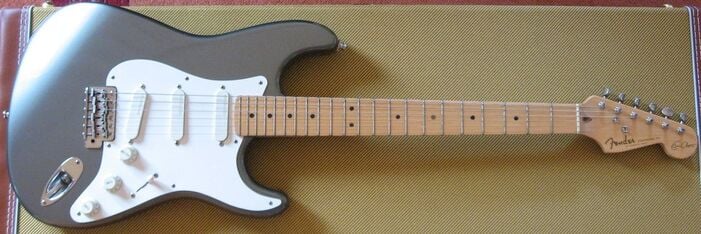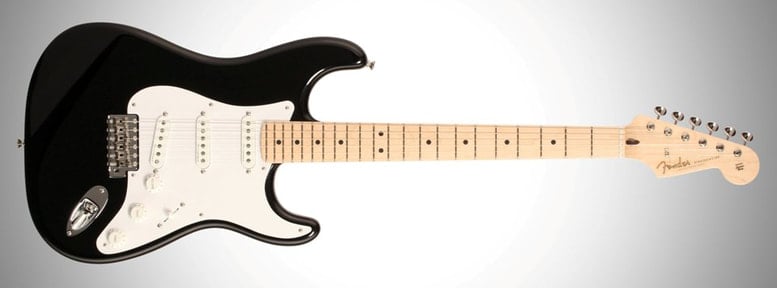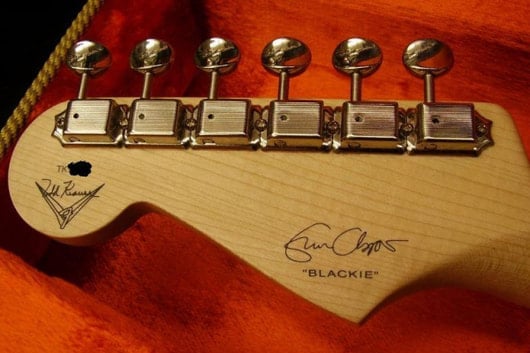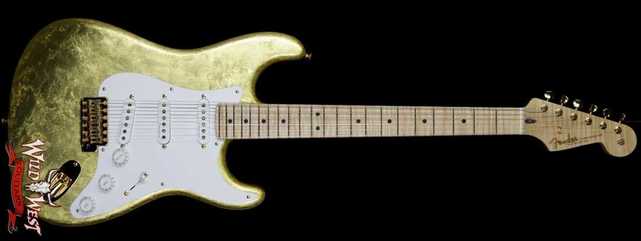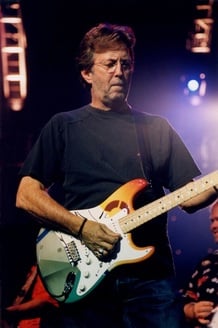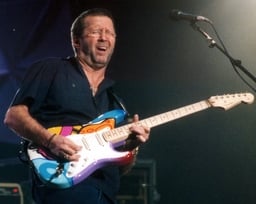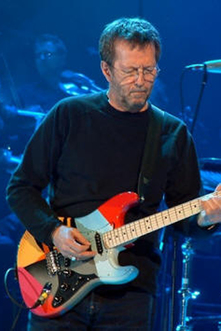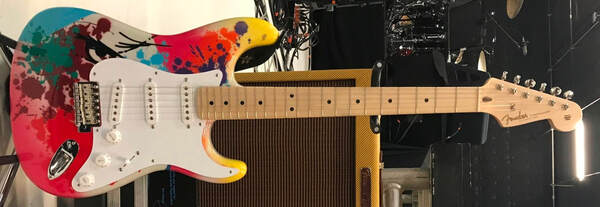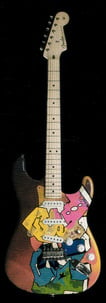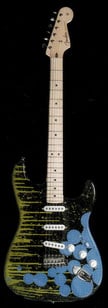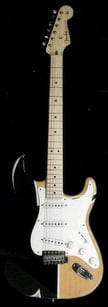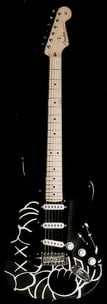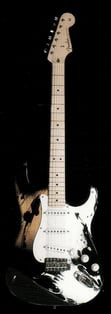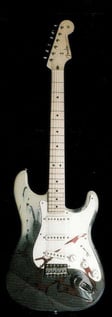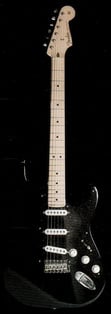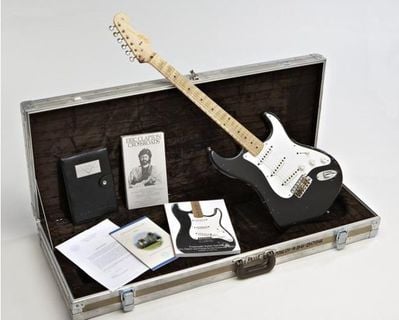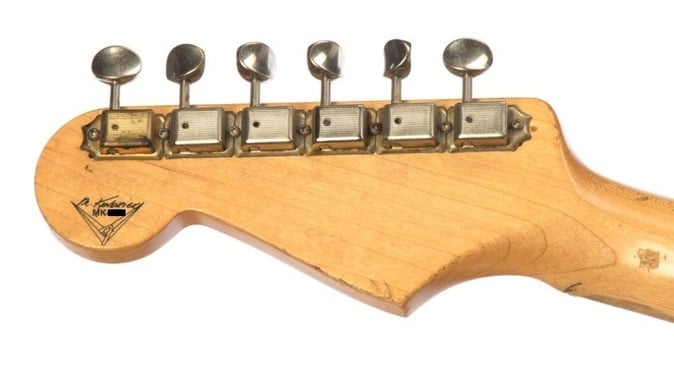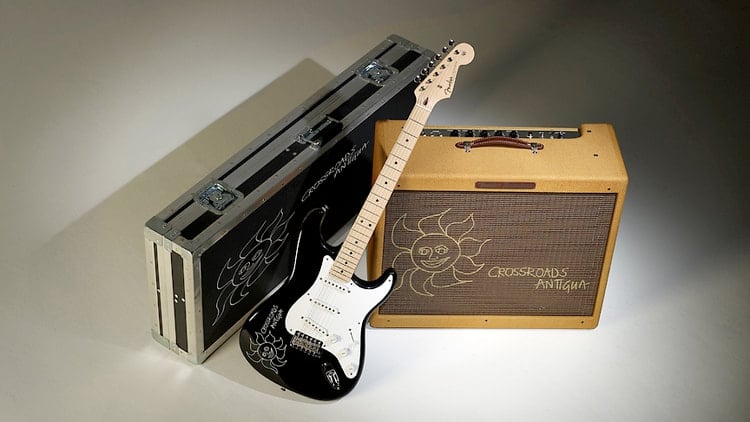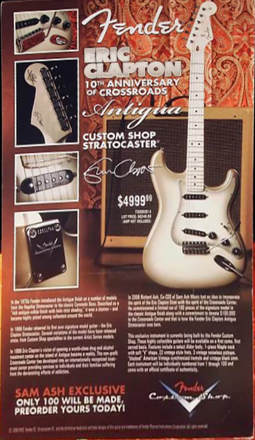bLACKIE AND THE ORIGIN OF THE SIGNATURE SERIES
|
In 1985 Eric Clapton had realised that unfortunately his beloved Blackie, an assembled "V" shaped neck Stratocaster from the late 1950s, had to be replaced as it couldn’t be subjected to another refret and couldn’t be played any more. “Blackie is simply worn out. It's unplayable. The problem is in the neck. The rest of the guitar is okay, but the neck is worn and the high E is popping off the fingerboard. The frets are almost down to the wood, and it's already been refretted once and couldn't take another refret. I've played it so much that even the sides of the neck, running along the length of the fingerboard, are wearing down - the neck is actually getting thinner. It's not even wide enough to support six strings, so I simply had to go with something else. The Fender guys came up with some ideas, and the guitars I'm playing now are the result,” Eric Clapton recalled in an interview with Tom Wheeler.
Actually both Master Builder Todd Krause and Clapton's guitar technician, stated in other interviews that Blackie was not so ruined, it simply exhibited the signs of wear and was a little more difficult to play, but Eric was still determined to change guitars. |
The real reason behind this change was that Fender proved their worth in this new age of corporate responsibility and systemic change by making a better guitar galvanizing Dan Smith’s original idea to make custom instruments for the major players because they wouldn’t play a new 1980s/90s Fender any other way!
The first signature should have been that of David Gilmour or Jeff Beck, but John Hill, Fender’s first Artist Relations and Brand Directors for Europe, had supplied Gilmour with six 1983 Strats and he didn’t therefore want the custom guitar offered: he was ecstatically happy and The Black Strat was ready for imminent retirement and exile to Dallas Hard Rock Café; Gilmour’s new number one Strat was an '83 Candy Apple Red seen on the Live Aid concert. Hill had visited Jeff Beck during the recording at Air Studios of Beck’s seminal ‘There and Back’ album with six prototype Dan Smith USA Vintage and Jeff wanted all of them instantly, so he was already on board and various custom offers had been made complicated by using various external luthiers in the UK and USA as this was pre Custom Shop and various trems and roller nut configurations.
The first signature should have been that of David Gilmour or Jeff Beck, but John Hill, Fender’s first Artist Relations and Brand Directors for Europe, had supplied Gilmour with six 1983 Strats and he didn’t therefore want the custom guitar offered: he was ecstatically happy and The Black Strat was ready for imminent retirement and exile to Dallas Hard Rock Café; Gilmour’s new number one Strat was an '83 Candy Apple Red seen on the Live Aid concert. Hill had visited Jeff Beck during the recording at Air Studios of Beck’s seminal ‘There and Back’ album with six prototype Dan Smith USA Vintage and Jeff wanted all of them instantly, so he was already on board and various custom offers had been made complicated by using various external luthiers in the UK and USA as this was pre Custom Shop and various trems and roller nut configurations.
|
John Hill had been going to Clapton private and public concerts, courtesy of Roger Forrester, Duck Dunn and Albert Lee, and also by working with Warner Bros Records promotional teams from the Another Ticket and the Money and Cigarettes albums. The first discussions about a custom made guitar to relieve Blackie’s plight started when John Hill visited The Arms Concert sound check at the Royal Albert Hall in September, 1983. On this occasion Hill arranged for a subsequent meeting two months later at the Forum in LA which Dan Smith was unable to attend and sent John Page and Freddie Tavares, with one of the first '57 Vintage Reissues to the guitarist who, at the time, was engaged in the ARMS Charity Concert. After this first meeting others followed.
|
In particular Dan Smith remembers that, on his birthday (April 5), he personally visited Clapton in Dallas in 1985. Eric was offered the two things each of the "Britpack" guitarists were offered, a custom guitar and a clone made of one of their most treasured instruments, but Clapton didn’t want a clone of Blackie, yet.
So the work on the custom one-off Stratocaster for endorsing Eric started.
John Hill, who was given Blackie, and Dan Smith drove him over to John Carruthers’ workshop in Santa Monica. Here Dan took the neck off Blackie and put it on a neck copying machine which had wheels that rolled around the Blackie neck and cut three exact copies.
So the work on the custom one-off Stratocaster for endorsing Eric started.
John Hill, who was given Blackie, and Dan Smith drove him over to John Carruthers’ workshop in Santa Monica. Here Dan took the neck off Blackie and put it on a neck copying machine which had wheels that rolled around the Blackie neck and cut three exact copies.
John Page and maybe George Blanda made three prototypes with wood blocked tremolo and the two neck profiles selected by Clapton: one in Torino Red finish (originally called Ferrari Red by Hill) on which he mounted the sharper "V" neck, and two Pewter, with a softer neck shape (which Clapton would have played later during the Prince Trust Live Aid, the Live in Montreux, and the Eric Clapton and friends shows in 1986). This finish was very similar to the anthracite wanted by Clapton and which he sometimes called Mercedes Charcoal Gray. These prototypes where equipped with three Gold Lace Sensors associated with a 21dB boost, because in various locations, including his management offices in Marylebone London, Eric described to John Hill that he’d always wanted a master volume control from his Marshall amp on the guitar itself, so again between London and California onboard preamps were trialed with a final successful candidate assembled and specced by George Blanda.
These guitars were shown to Eric while recording his August album: the guitarist was so enthusiastic that he also recorded some solos of his album with the prototypes.
These guitars were shown to Eric while recording his August album: the guitarist was so enthusiastic that he also recorded some solos of his album with the prototypes.
The contract between Eric Clapton and Fender Musical Instruments was signed on May 7, 1987, by Roger Forrester, his manager and witnessed by John Hill, co-signed for Fender. John had been negotiating with Roger Forrester over an extended period of time and eventually Roger said Eric hadn’t done any endorsement contracts before.
|
So this was a world first and it incorporated Hill’s idea of making the new custom Strat made to Eric Clapton’s specifications available for sale to the public, which was not originally ever intended as it was just to get Eric playing contemporary Strats rather than pre-CBS Strats. At First Dan Smith and Bill Schultz weren't keen because they thought it was a Gibson thing.
But John showed Roger Forrester, Bill Schultz and Dan Smith the Stewart Copeland advert he made, and they all said “let's put it in the contract”, so that they had the option to do something about it in future. The Eric Clapton Signature Stratocaster was born. |
In the same year, the Custom Shop produced the very first models of the new vintage looking signature guitar, the Eric Clapton Statocaster (1st model pre-factory), reminiscent of a ’57 Stratocaster with the characteristic 21 frets and a sharp “V” maple neck, but equipped with three Gold Lace Sensors, a TBX tone control, a MDX circuit, which ensured a 21dB boost on the mids, a flatter fretboard and a tremolo blocked with a piece of wood. As a distinctive feature of the new series, the guitarist’s signature was applied on the front of the headstock. Also a small switch to select the active and passive electronics was inserted on these first models, mostly quite rare prototypes.
One of the first signature ever built, "pre-factory" Clapton Stratocaster, dated 1987, mini switch on the pickguard and 21 frets (Courtesy of Andrew Kastner).
|
But at the beginning of 1988, before the factory production started, Eric asked for three more guitars and a new neck for one of the two Pewter original prototypes. It wasn’t an easy job: Eric was increasingly demanding and John Hill was rubbing down necks and getting Robbie Gladwell in England to age the guitars as Eric told John he didn’t want to play a guitar that looked or felt like new. This process is what became known as relicing, but John called it antiquing as Gladwell’s workshop was like that of a characterful TV Antiques dealer played by Ian McShane who ‘aged’ furniture to make it look older than it actually was!
So other necks similar to that of Blackie as scanned by John Carruthers were built in the Fender Custom Shop and George Blanda and John Page mounted them on two new prototypes, one Pewter and the other Candy Apple Green, also called 7-Up Green, a color that Clapton had recently made on a Giffen Strat using Patti’s nail varnish. |
This time the slightly softer shaped necks (curly maple for the Pewter and bird's eye for the 7-Up Green) were perfect. Michael Stevens was asked to reverse the necks of the new Pewter and of the Candy Apple Green and to add the twenty-second fret to the green Stratocaster (which subsequently would have been refinished in Black).
Dan Smith had suggested adding the twenty-second fret which was now possible as the Corona facility was coming to life and adding new capabilities and processes which the custom shop builders as they grew were able to take advantage of on all Clapton signatures and the BiFlex truss rod, which Smith had originally conceived back in 1981, while, on Clapton’s request, the mini-switch was eliminated and the boost was increased to 25 dB. These new rare models (sort of pre-factory prototypes) made by Custom Shop were followed by the factory production of the new Eric Clapton Stratocaster (1st series), at first available only in Torino Red, Candy Apple Green and Pewter; in 1991 the Black finish was added and in 1994 the Olympic White one. The black signatures exhibited the “BLACKIE” decal together with Clapton’s signature; however, it is important not to confuse these guitars with the Blackie Tribute Replica made in limited edition in 2006 without this decal.
Dan Smith had suggested adding the twenty-second fret which was now possible as the Corona facility was coming to life and adding new capabilities and processes which the custom shop builders as they grew were able to take advantage of on all Clapton signatures and the BiFlex truss rod, which Smith had originally conceived back in 1981, while, on Clapton’s request, the mini-switch was eliminated and the boost was increased to 25 dB. These new rare models (sort of pre-factory prototypes) made by Custom Shop were followed by the factory production of the new Eric Clapton Stratocaster (1st series), at first available only in Torino Red, Candy Apple Green and Pewter; in 1991 the Black finish was added and in 1994 the Olympic White one. The black signatures exhibited the “BLACKIE” decal together with Clapton’s signature; however, it is important not to confuse these guitars with the Blackie Tribute Replica made in limited edition in 2006 without this decal.
Second "pre-factory" model, dated 1988. There is no longer the mini switch. The old Custom Shop oval logo stood out on the back of the headstock. This color is not very common. (Very special thanks to Nino Fazio from realvintage.it)
In 1991 Fender, in agreement with Clapton, produced some signatures with rosewood fretboards to meet the tastes of the guitarists that didn’t like the maple ones. However only 95 units were made and sold before the production stopped.
The Clapton Stratocaster was equipped with the Lace Sensors until 2001, when they were replaced by the new Vintage Noiseless. Though the contract with the Actodyne General, producer of the Lace Sensors, ended in 1996 and Fender gradually began to substitute them with the new Noiseless, Lee Dickson declared that it was Eric who preferred the Noiseless to the old pickups. The Second Clapton Series was born.
The Master Builder Mark Kendrick, who built many guitars for Eric Clapton, said he preferred the sound of the Lace Sensors to the Vintage Noiseless pickups. He also didn’t like the sound of the TBX and removed them from the guitars he built for the guitarist, who didn’t care one way or the other about that particular change.
The Clapton Stratocaster was equipped with the Lace Sensors until 2001, when they were replaced by the new Vintage Noiseless. Though the contract with the Actodyne General, producer of the Lace Sensors, ended in 1996 and Fender gradually began to substitute them with the new Noiseless, Lee Dickson declared that it was Eric who preferred the Noiseless to the old pickups. The Second Clapton Series was born.
The Master Builder Mark Kendrick, who built many guitars for Eric Clapton, said he preferred the sound of the Lace Sensors to the Vintage Noiseless pickups. He also didn’t like the sound of the TBX and removed them from the guitars he built for the guitarist, who didn’t care one way or the other about that particular change.
2004: tHE eRIC cLAPTON cUSTOM aRTIST mODEL
In 2004 the team-built Custom Shop Eric Clapton Signature Stratocaster was introduced; it was identifiable by the Clapton's signature, together with the Custom Shop Logo, which were applied on the back of the headstock.
Midnight Blue, Mercedes Blue and Black were the available finishes. Also the black Custom Shop signatures, like the factory ones, exhibited the "BLACKIE" decal together with Clapton’s signature and not to be confused with the Blackie Tribute Replica made in limited edition in 2006.
Eric Clapton Signature Stratocaster master-built models were also made; they were slightly different from the team-built ones: better woods and paints, different frets, but above all, necks with different profiles and without TBX. In 2009 Todd Krause declared that the team built had TBX because when it was created in 2004 Eric used it and the guitar was never changed; on the contrary the master-built was always updated in tune with the variations that Eric made on his guitars and, as he no longer used TBX and the necks had different shapes, these changes were also implemented in the master built versions of the Clapton signature.
In 2017 the Journeyman Relic Eric Clapton Signature Stratocaster team-built version with aged 2-Color Sunburst or Aged White Blonde finish, was presented.
Midnight Blue, Mercedes Blue and Black were the available finishes. Also the black Custom Shop signatures, like the factory ones, exhibited the "BLACKIE" decal together with Clapton’s signature and not to be confused with the Blackie Tribute Replica made in limited edition in 2006.
Eric Clapton Signature Stratocaster master-built models were also made; they were slightly different from the team-built ones: better woods and paints, different frets, but above all, necks with different profiles and without TBX. In 2009 Todd Krause declared that the team built had TBX because when it was created in 2004 Eric used it and the guitar was never changed; on the contrary the master-built was always updated in tune with the variations that Eric made on his guitars and, as he no longer used TBX and the necks had different shapes, these changes were also implemented in the master built versions of the Clapton signature.
In 2017 the Journeyman Relic Eric Clapton Signature Stratocaster team-built version with aged 2-Color Sunburst or Aged White Blonde finish, was presented.
oTHER ERIC CLAPTON sPECIAL GUITARS
During the years, Fender Custom Shop had made special editions of the Clapton Stratocaster, but also some guitars only for Slow Hand.
For the recording of the 1992 Jimi Hendrix Stone Free tribute album, Eric asked the Custom Shop to build a special Stratocaster based on his white signature, but equipped with the Texas Special pickups. This guitar has been used many times in studio but never played live.
For the recording of the 1992 Jimi Hendrix Stone Free tribute album, Eric asked the Custom Shop to build a special Stratocaster based on his white signature, but equipped with the Texas Special pickups. This guitar has been used many times in studio but never played live.
The Gold Leaf Stratocaster
The Gold Leaf Stratocaster is a custom order guitar made by the Master Builder Mark Kendrick in 1996 for the 50th anniversary of Fender.
Eric was looking for something that had an old appearance, something “that could be hung in the Louvre,” the English guitarist remembers, and after three attempts this Stratocaster arrived: it was composed by a two piece alder body with a golden foil finish applied by George Amicay, covered by a thin and transparent lacquer. The neck plate, on which the “EC1” serial number was engraved, refers to Fender anniversary. Mark Kendrick remembers that this guitar at first had a completely golden pickguard, which Clapton immediately replaced with a white one.
Clapton played this Stratocaster between ’96 and ’97; its last appearance dated to 2001, during the One More Car, One More Rider tour, before being sold for $455,000.
In 2004 Custom Shop master builders re-purposed it with the name Clapton Gold Leaf Stratocaster in 50 unit limited edition, equipped with Vintage Noiseless pickups and standard tone control, instead of the Gold Lace Sensors and the TBX present on the original Gold Leaf Strat and with the "ORIGINAL Contour Body" decal, which the original did not have.
It is still possible to order a Gold Leaf Replica from the master builders of the Custom Shop.
Eric was looking for something that had an old appearance, something “that could be hung in the Louvre,” the English guitarist remembers, and after three attempts this Stratocaster arrived: it was composed by a two piece alder body with a golden foil finish applied by George Amicay, covered by a thin and transparent lacquer. The neck plate, on which the “EC1” serial number was engraved, refers to Fender anniversary. Mark Kendrick remembers that this guitar at first had a completely golden pickguard, which Clapton immediately replaced with a white one.
Clapton played this Stratocaster between ’96 and ’97; its last appearance dated to 2001, during the One More Car, One More Rider tour, before being sold for $455,000.
In 2004 Custom Shop master builders re-purposed it with the name Clapton Gold Leaf Stratocaster in 50 unit limited edition, equipped with Vintage Noiseless pickups and standard tone control, instead of the Gold Lace Sensors and the TBX present on the original Gold Leaf Strat and with the "ORIGINAL Contour Body" decal, which the original did not have.
It is still possible to order a Gold Leaf Replica from the master builders of the Custom Shop.
The "Graffiti" Stratocasters
Lee Dickson, one of the technicians who supported Slow Hand over the years, remembers that Eric played, most of the time, two guitars built by Master Builder Todd Krause, which were identical to the factory signature Stratocasters including the Vintage Noiseless pickups. They differed from most guitars because of their weight, which contrasted with the trend of the period that wanted guitarists looking for lighter and lighter bodies. On the occasion of his 2001 tour, Clapton sent the bodies of his guitars to John Matos, better known as Crash, a famous New York graffiti artist, who painted them by hand; subsequently the bodies returned to Todd Krause for the clear coating and the assembly.
“Creating a painted guitar is very different than painting a canvas. Canvases are painted against a wall, or easel. Walls, well, they don't move, as simple as can be. The Stratocaster has no edges, the designs revolve from front to back, so it's quite tricky. Also, because of that same reason, when I paint them, I hang them from the ceiling so that I can easily move them, therefore creating a seamless design... yes, tricky indeed,” John declared in 2019.
Clapton Crashocasters debuted at the 2001 Wyclef Jean All-Star Jam at Carnegie Hall. They were also used for the 2001 Reptile Tour, in the Ain’t gonna stand for it video and in other live performances.
“Creating a painted guitar is very different than painting a canvas. Canvases are painted against a wall, or easel. Walls, well, they don't move, as simple as can be. The Stratocaster has no edges, the designs revolve from front to back, so it's quite tricky. Also, because of that same reason, when I paint them, I hang them from the ceiling so that I can easily move them, therefore creating a seamless design... yes, tricky indeed,” John declared in 2019.
Clapton Crashocasters debuted at the 2001 Wyclef Jean All-Star Jam at Carnegie Hall. They were also used for the 2001 Reptile Tour, in the Ain’t gonna stand for it video and in other live performances.
Between 2004 and 2007 Crash painted other fifty Stratocasters made by Todd Krause - although not Clapton signatures - each with a different design, which exhibited a Crash signature on the neck plate and that of the master builder on the back of the headstock. They featured a metallic pickguard, similar to that of the Crash #3, equipped with black covered Noiseless pickups. Despite this, many Crashcaster guitars that aren’t designed by John Matos, but pretend to be, circulate nowadays.
In 2019 Crash painted a new Crashocaster, which Eric Clapton played at the 2019 Crossroads Guitar Festival in Dallas.
In 2019 Crash painted a new Crashocaster, which Eric Clapton played at the 2019 Crossroads Guitar Festival in Dallas.
In an interview with the Where's Eric #34 magazine, Clapton declared that he had commissioned an entire “graffiti” series and claimed to own, besides the Crashcasters used live, other eight guitars painted by other artists including Stash, Daze and Futura. The photos of these guitars were published in the next edition of the magazine.
The other "Graffiti" Stratocasters published in Where's Eric magazine
The Blackie Tribute Replica
Blackie was a “partcaster” put together by Eric Clapton from parts from three different Fender Stratocasters.
Clapton declared he was in Nashville at a store called Sho-Bud, which had a whole rack of old ’50s Fender Stratocasters going second-hand. At that time, these guitars were so out of fashion that you could pick up an original pre-CBS Stratocaster for two or three hundred dollars!
So, Eric bought six or seven Stratocasters. He gave one to Steve Winwood, one to George Harrison, and one to Pete Townshend, and kept the others for himself.
He liked the black body of a Stratocaster that was in bad condition, so he kept the body and assembled it with different parts to make Blackie — pickups from one guitar, pickguard from another, and the neck from another one.
Over the years, Eric Clapton called Blackie “a part of me.” In 2004, Blackie was named as one of the top ten Fender Stratocasters “to die for” by Fender G.B. Ireland.
Blackie debuted at the Rainbow Concert on 13 January 1973. It was been primary stage and studio guitar between 1970 and 1985. Not only had it been in the studio for every album recorded during that time, it was also used at famous events — as the ARMS benefit tour and Live Aid — and in Eric’s first music video, Forever Man.
In 1985, Blackie was retired.
Blackie ventured out of retirement on two occasions while still in Eric Clapton’s ownership: a television commercial for Honda Cars Japan in 1990 and at the Royal Albert Hall in 1991.
Cream of Eric Clapton”. The guitar was also featured on a t-shirt sold during Eric’s 2004 World Tour.
On 24 June 2004, Blackie was auctioned at Christie’s Auction House, New York, to raise funds for Crossroads Centre Antigua, a drug and alcohol abuse rehabilitation center founded by Clapton in 1998. The guitar was purchased by the Guitar Center — represented by David Belzer and Drew Berlin, known among vintage lovers as the Burst Brothers — for $959,500.
About a year later, on October 24, 2005, the guitar was “loaned” to the Corona Custom Shop to be inspected. In 2006, the Guitar Center, with Eric Clapton’s approval, announced it would issue a limited edition of Blackie replicas as a part of the Fender Master Built Tribute Series.
Custom Shop Master Builders, under the supervision of Todd Krause, manufactured 275 Blackie Tribute Replica Stratocasters. On 17 May 2006, Eric played the first Blackie Prototype for three songs during his concert at London’s Royal Albert Hall.
On 24 November 2006, the guitars went on sale to the public and sold out in one day, for an amount that was around $ 20,000 per guitar. A part of the proceeds was donated to charity to the Crossroads Centre.
The replicas were obviously unsigned (and did not have the "BLACKIE" decal, present on all black signatures, with which they should not be confused) and also exhibited signs of cigarette burns on the headstock. Though the hardware was nickel and the tuning machines were chromed (all aged), the key of the high E was golden and oxidized like that of the original.
Clapton declared he was in Nashville at a store called Sho-Bud, which had a whole rack of old ’50s Fender Stratocasters going second-hand. At that time, these guitars were so out of fashion that you could pick up an original pre-CBS Stratocaster for two or three hundred dollars!
So, Eric bought six or seven Stratocasters. He gave one to Steve Winwood, one to George Harrison, and one to Pete Townshend, and kept the others for himself.
He liked the black body of a Stratocaster that was in bad condition, so he kept the body and assembled it with different parts to make Blackie — pickups from one guitar, pickguard from another, and the neck from another one.
Over the years, Eric Clapton called Blackie “a part of me.” In 2004, Blackie was named as one of the top ten Fender Stratocasters “to die for” by Fender G.B. Ireland.
Blackie debuted at the Rainbow Concert on 13 January 1973. It was been primary stage and studio guitar between 1970 and 1985. Not only had it been in the studio for every album recorded during that time, it was also used at famous events — as the ARMS benefit tour and Live Aid — and in Eric’s first music video, Forever Man.
In 1985, Blackie was retired.
Blackie ventured out of retirement on two occasions while still in Eric Clapton’s ownership: a television commercial for Honda Cars Japan in 1990 and at the Royal Albert Hall in 1991.
Cream of Eric Clapton”. The guitar was also featured on a t-shirt sold during Eric’s 2004 World Tour.
On 24 June 2004, Blackie was auctioned at Christie’s Auction House, New York, to raise funds for Crossroads Centre Antigua, a drug and alcohol abuse rehabilitation center founded by Clapton in 1998. The guitar was purchased by the Guitar Center — represented by David Belzer and Drew Berlin, known among vintage lovers as the Burst Brothers — for $959,500.
About a year later, on October 24, 2005, the guitar was “loaned” to the Corona Custom Shop to be inspected. In 2006, the Guitar Center, with Eric Clapton’s approval, announced it would issue a limited edition of Blackie replicas as a part of the Fender Master Built Tribute Series.
Custom Shop Master Builders, under the supervision of Todd Krause, manufactured 275 Blackie Tribute Replica Stratocasters. On 17 May 2006, Eric played the first Blackie Prototype for three songs during his concert at London’s Royal Albert Hall.
On 24 November 2006, the guitars went on sale to the public and sold out in one day, for an amount that was around $ 20,000 per guitar. A part of the proceeds was donated to charity to the Crossroads Centre.
The replicas were obviously unsigned (and did not have the "BLACKIE" decal, present on all black signatures, with which they should not be confused) and also exhibited signs of cigarette burns on the headstock. Though the hardware was nickel and the tuning machines were chromed (all aged), the key of the high E was golden and oxidized like that of the original.
The Sun Strat
In 2007 Fender released a hundred Eric Clapton Crossroads Stratocasters (known also as Sun Strat) and fifty Crossroads '57 Twin Amps, produced simultaneously. Proceeds from the sale of these packages went to the drug and alcohol abuse rehabilitation center founded by Clapton, the Crossroads Centre in the Caribbean island of Antigua. Each guitar and each amp bore a unique Crossroads Antigua drawing, a smiling sun designed by Eric himself.
10th Anniversary Crossroads Antigua Clapton StratocasterIn 2008, on the occasion of the 10th anniversary of the Crossroads Center in Antigua, Richard Ash, CEO of Sam Ash Music, asked Fender Custom Shop to produce, for charity purposes, a limited edition Stratocaster to bring back to life the Antigua finish of the late '70s, maybe one of the most controversial color of Fender history.
Corona factory made one hundred units of the Eric Clapton Antigua 10th Anniversary Crossroads Stratocaster, sold each for $5,000, of which 1000 were donated to the recovery center. This Stratocaster, which followed the specs of the Custom Artist Clapton Strat (alder body, 1-piece maple neck with soft "V" profile, 22 vintage style frets, Vintage Noiseless pickups, blocked vintage style tremolo, MDX, TBX), was refined by Jesus Andrade, who had painted the Antigua Stratocasters between 1977 and 1979. |
2010 Limited Eric Clapton Signature Stratocaster
|
In 2010 the Custom Shop released the Limited Eric Clapton Signature Stratocaster, available both in the Daphne Blue finish, a meticulous copy of the guitar that Eric used in his Australian tour in 2009, and in the Gray version, a color slightly darker than Pewter, a faithful replica of his Fender played in the 2006 and 2007 world tour.
Both had an alder body, soft "V" maple neck, 22 vintage style frets, bone nut, Vintage Noiseless pickups, MDX and blocked vintage style tremolo; they could be distinguished from similar models for the "LIMITED EDITION" decal present together with the Custom Shop logo on the back of the headstock. |
Brownie Tribute Replica
Brownie was Eric Clapton’s first Stratocaster and one of his favorite guitars. He bought it at Sound City in London on May 7th, 1967, while he was still with Cream.
Eric used Brownie extensively for recordings and concerts over several years. Notably, on his first solo album Eric Clapton, 1970, where it shares the front cover photograph with him; and more significantly in the same year, on the whole of the Layla album — including the title track — where Brownie was again pictured on the album cover, this time on the back, photographed on the floor of Criteria Studios.
On 24 June 1999, Clapton sold Brownie for $497,500 through Christie’s Auction House in New York City to help raise funds for his alcohol and drug treatment center, Crossroads Centre in Antigua. Brownie sold
Brownie was a 1956 2-Color Sunburst Fender Stratocaster, serial number 12073. It sported the initials XA and the date 6-56 in pencil on the heel of the neck, while the body was dated 6-56. Eric used a black rectangular hardshell case stenciled on both sides in yellow “DEREK AND THE DOMINOS” and “FRAGILE” and Lee Dickson's handwritten tie-on label inscribed “1956 Strat 2073 2TSB BR.”
In an interview with Fred Stuckey printed in Guitar Player of June 1970, Eric said that even though at that time he was still playing a Les Paul, he used Brownie with Delaney & Bonnie because it had a great sound and because “it's just right for the kind of bag I was playing with them.”
Stuckey also asked Clapton: “Have you done anything to the Stratocaster - like modify the pickups or have the frets shaved?” Clapton replied: “No. I just set the switch between the first and middle pickups. There is a little place where you can catch it so that you can get a special sound somehow. I get much more rhythm and blues or rock kind of sound that way.”
Eric used Brownie extensively for recordings and concerts over several years. Notably, on his first solo album Eric Clapton, 1970, where it shares the front cover photograph with him; and more significantly in the same year, on the whole of the Layla album — including the title track — where Brownie was again pictured on the album cover, this time on the back, photographed on the floor of Criteria Studios.
On 24 June 1999, Clapton sold Brownie for $497,500 through Christie’s Auction House in New York City to help raise funds for his alcohol and drug treatment center, Crossroads Centre in Antigua. Brownie sold
Brownie was a 1956 2-Color Sunburst Fender Stratocaster, serial number 12073. It sported the initials XA and the date 6-56 in pencil on the heel of the neck, while the body was dated 6-56. Eric used a black rectangular hardshell case stenciled on both sides in yellow “DEREK AND THE DOMINOS” and “FRAGILE” and Lee Dickson's handwritten tie-on label inscribed “1956 Strat 2073 2TSB BR.”
In an interview with Fred Stuckey printed in Guitar Player of June 1970, Eric said that even though at that time he was still playing a Les Paul, he used Brownie with Delaney & Bonnie because it had a great sound and because “it's just right for the kind of bag I was playing with them.”
Stuckey also asked Clapton: “Have you done anything to the Stratocaster - like modify the pickups or have the frets shaved?” Clapton replied: “No. I just set the switch between the first and middle pickups. There is a little place where you can catch it so that you can get a special sound somehow. I get much more rhythm and blues or rock kind of sound that way.”
|
In February 2013, Fender announced a Custom Shop reproduction of Brownie available exclusively through Guitar Center on 21 March 2013. The Eric Clapton Brownie Tribute Stratocasters were meticulously manufactured by Custom Shop Master Builder Todd Krause.
The whole project cost Todd about a year of work: “It might have seemed to the public that it took a couple of months, but I had been working in secret for months and months before word went out.” The one hundred replicas made featured a nitro-finished 3-piece alder body, a custom large soft "V" shaped maple neck, 21 vintage style frets, Custom Shielded '56 Stratocaster pickups, a five-way switch, a vintage style bridge, and nickel hardware. The instrument reproduced the original guitar in the smallest details, down to the smallest scratches and dents; even the cigarette burns and the asymmetrical 2-Color Sunburst finish of the body were the same as the real Brownie. The guitar was sold with a replica of Brownie’s special case and a certificate of authenticity, numbered and hand-signed by Clapton. |
Antonio Calvosa
Thanks to Giovanni Gelli
